
METHODISM IN CALIFORNIA
By Rev. A. C. Hirst, D. D., LL. D.
No. II
January, 1893.
HOWARD STREET CHURCH
The present Howard Street
church, with its increasing prosperity and commanding influence, is the
fruitage of those days of struggle and self-sacrifice. It's auditorium and parlors that have
recently been made so beautiful and attractive, at a cost of $10,000, through
the influence and under the personal supervision of J. W. Whiting, are in
strong contrast with the school-house where the faithful few once worshipped in
planned for the future church. The
electric lights that now eliminate the auditorium and the parlors are far more
cheerful and healthful and conductive to devout worship than the whale-oil
lamps that Mr. Whiting used to prepare for the infant church when, in
his.undying zeal for the prosperity of Zion, he was willing to perform such
service.
A new era of usefulness
opens for this church under the enthusiastic leadership of Rev. W. W. Case, D.
D. . This historic church is so
situated in reference to the present population of San Francisco that it will
be one of the most potent factors to solve the problem of reaching the masses
with the Gospel and purifying the streams of social and municipal life. The vigorous hammer-strokes of the present
pastor during the recent white-heated contest for municipal reform have proved his
eminent fitness for the great work now before him.
At a jubilee service held there
August 12, 1883, the Rev. D. A. Dryden, who was appointed pastor of the Folsom
street church in 1855, gave the vividly prophetic picture of those days of
crucial trial and severe testing of faith and loyalty.
"The inner heart-history
of this church during that time will never be written. It was anything but a time of jubilee. It was a struggle for life rather than a time
of triumph. There was more of
Gethsemane then of the Mount of Transfiguration. Like individuals, churches have their birth, childhood and mature
growth. Like individuals, some are born
healthy and strong, with all the potencies of a rapid, vigorous growth and
sturdy maturity, and favored with all the conditions for such growth. Such, Folsom street church was not. It was born feeble--some thought
prematurely--had a sickly childhood, environed by adverse conditions which
often threatened to cut short its career.
"During the year or
1855 was perhaps the severest struggle for life. Congregations were very small, membership few, rather poor. Income from every available source sadly
below even in the most economical expenses; crushed under a burden of heavy
debt with constantly accumulating interest, the heart-struggles of pastor and a
few noble souls are known only to the Good Master. Surely there were no visible signs then of powerful manhood into
which the feeble child has grown.
"And who knoweth to
what extent, under the brooding Providence of God, the baptism of those days of
trial may have contributed to this growth?
Not always in prosperity does life strike its deepest roots even in the
church or the individual."
These words sell like the
leaping bugle notes of some brave leader at the head of the call of that rushes
fearlessly into battle.
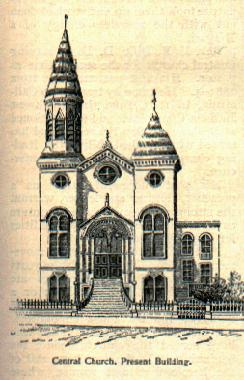
CENTRAL CHURCH
Everywhere difficulty,
opposition, friction are the essential condition of strength, vigorous growth
and life. Only the soul that is taxed
yields revenue. No enemy, no
glory. The stronger the foe the grander
the victory. The typical Christian is
the man around whose sole have been kindled the fires of the furnace.
Thus virtue is evoked and
fortified; character is rounded into symmetry and proportioned, and asserts
itself with the majestic force. The
history of exalting ideas is developed through antagonistic powers.
The grand moment of
civilization describes the spiral of the calculus--progressive, but
revolutionary. This antithesis of
things is as wide as the domain of existence.
Against the season of blooming, fragrant flowers is the withering blight
of frost. Against the radiant glories
of the future our darkest hues of care and the cold shadows of a disenchanting
experience. Against the Tabor of
promise are the ashes of Golgotha. No
great truths can be born or live in a dead calm of thought.
The embarrassments that
challenged the expectations of the trustees of Howard Street church served only
as an inspiration for aggressive work.
Upon the south side of Mission Street, between Sixth and Seventh, they
built a small chapel. Here a Sunday
school was organized, which soon assumed a progressive life and enriching
influence. Around this a strong
organization crystallized. At the
session of the California Conference, in 1864, it took its place as the Central
Methodist church. Before the expiration
of the lease, the trustees, wisely planning for the future, purchased a most desirable
lot on the corner of Sixth end Mission streets, and transferred the little chapel
to that place. Financial inability to
meet the payments compelled the sale of that lot and the purchase of one on
which the present edifice stands. The
little chapel was rapidly making history as an itinerant. Lifted again on wheels, it was placed to that
resting place. Precious memories
clustered at its altar, and hallowed associations were there formed, which will
last through the eternal ages. Who can
measure the mighty sweep of all that was crystallized into action and deed
there?

Human potentialities thus
trained and equipped to give to the world that pure civilization whose very
atmosphere is conquering power.
Thus, every true man adds
his ray to the on-marching glory that shall at last robe this old world in
millennial splendor.
It was most auspicious
that the first pastor of this new organization was the Rev. J. D. Blain, D.
D.. He was transferred to California
from the New Jersey Conference, in 1852 and was first stationed at Grass
Valley. Afterwards he was presiding
elder of the Sacramento District, and from 1854 to 1857 he was on the San
Francisco District.
In 1861 he became pastor
of Folsom street church. His pastorate
was crowned with a phenomenal success.
A most worthy tribute to his memory is paid by R. McElroy, who, in writing
of his pastorate at that church, says: "His appointment was an exceedingly
fortunate one for the society, for he came to us determine to give us the full
benefit of his great ability. This ability
did not consist of wonderful pyrotechnic displays of pulpit eloquence, and yet
he was eloquent; nor did it consist in massive demonstrations of logic, and yet
he was logical; but it did consist in the wonderful symmetry of his character,
within all the forces of his nature were so adjusted as to be worked to the
highest degree of usefulness. He had
untiring industry; time was too precious to him to squander a single
moment. He had intense devotion to his
work--all his thoughts centered on this.
He had common practical sense to the highest degree; there was nothing
visionary or unfeasible about his plans, but they were related in the highest
wisdom, and when brought to their practical working, developed into the most
vital efficiency. He had the most
perfect knowledge of human nature, and knew just how to touch the secret
springs of every person with whom he came in contact. He was, therefore, a born leader of men. His will was indomitable, his energy unflagging. He knew no discouragements, and could brook
no failure. When once his plans were
settled, his impetuous nature took them up and worked them out with the
resistless energy of a Niagara."
Rev. E. R. Dille, D. D.,
is serving Central church for the second time as pastor. His first pastorate was from 1881-4. He came by transfer to California, in 1873,
from the Northwest Indiana Conference, and was stationed at Bush Street, San
Francisco, and has served with marked ability the leading the charges of the
California Conference.
His past successful career
as a preacher, lecturer and leader, warrant the strong prophecy for a larger
future as he wields the present possibilities for aggressive work.
Full details of the onward
movement of Methodism through the years are impossible. These articles are not formulated as a
year-book or a census record. Of
necessity many items of interest must be omitted. Special mention of all the pastors who have served the churches
since the beginning of Methodism here, and of the heroic men and women whose
achievements signalized the present, is impossible.
Only a glimpse can be
given of that past history, enshrining the perplexing problems of a new
country, controlling the purposes of adventurous pioneer, in evangelizing the
thousands rushing to the shores in search of gold, pre-emptying the State for
God, and laying the foundation stones of the Christian civilization, which is
the only pledge for the State or nation to secure permanence or prosperity.

GRACE CHURCH
In 1852, Rev. H. B.
Sheldon, aided by I. Lockwood and William Thomas, held religious
services regularly in a schoolhouse on Delores street.
As a result of that, in due
time Rev. R. B. Stratton secured a lot, on what is now Julian Avenue, between Fifteenth
and Sixteenth streets, and built a plain chapel thereon. But it was the same sad experience of other
church enterprises. Financial
difficulties challenged the worker, and loss of the property was the
result. But the demand for a church in
that part of the city grew more and more imperative. Two Sabbath-schools were organized in 1863. The one by Charles Lelong on the corner of
Howard and Twenty-third streets; the other by H. Thomas, E. J. Hargrave and N. B.
Cook on Howard between Twelve and Thirteenth streets. These schools were the nucleus of the church which Dr. Blain
organized in 1864. It was named the
Mission Street M. E. Church, with Henry Thomas, J. Mysell, N. B. Cook, T. H.
Downing, Joseph Garratt and E. J. Hargrave, as Trustees. A lot on the east side of Mission streets,
between Eighteenth and Nineteenth, was generously donated by John Center. Here was built a lecture-room 50 by 52 feet,
at a cost of about $2,500. In May,
1865, it was dedicated for regular preaching and Sunday school services. The name was changed from "Mission
Street" to "Grace" in 1876.
With some valuable improvements this building served the purpose and
needs of this society until increasing prosperity made it necessary to plan for
a more suitable church home.
In September, 1883, Rev.
H. B. Heacock, D. D., was appointed pastor of this church for the second
time. With his characteristic zeal and
wisdom he planned and worked with surprising results. In July, 1886, the trustees purchased the tract of land having
Mission, Capp and Twenty-first streets as boundary lines. For this they paid $30,000 cash. They were successful in selling several
lots, reserving a cost of $7,000 the present lot on the corner of Capp and Twenty-first
streets. For the church and lot on
Mission street $8,000 were realized.
The organization of the building committee was the index of the certain
success of this new enterprise. That
committee was constituted as follows: Rev. H. B. Heacock, D. D., President; J.
W. Butler, Secretary; C. S. Holmes, Robert Husband, I. G. Truman, G. W. Lemont,
J. L. Culin, W. H. Coddington, C. L. Todd, G. W. Wittman.
A special subscription of
$10,000 gave an irresistible stimulus to these workers, and their efforts and
plans were crowned with a splendid success.
The present spacious, beautiful and well-arranged church was dedicated November
5, 1886. It was a monument to the
indefatigable efforts and unyielding courage of Dr. Heacock. He came from the Des Moines Conference,
Iowa, in 1868 and was first stationed at this church, situated than on Mission
street. He has proved his master skill
in building new churches and in remodeling and beautifying old ones, in his
pastorates at Sacramento, Stockton, Alameda and notably East Oakland, where,
under his direction, a most attractive church, modern in all its appointments
and an ornament to the city, has been erected.
It is known as the Eighth Avenue M. E. church.
Rev. Eli McClish, D. D.,
as present pastor of Grace, is leading forth its membership to increasing
usefulness. Its surge of power is felt
in the city. His special training in
boyhood, and as a soldier, student, pastor, teacher, has equipped him for the
peculiar conditions that environ Christian work on this coast. His qualifications are masterful and his
distinctive force is capable of winning reward in whatever field he labors.
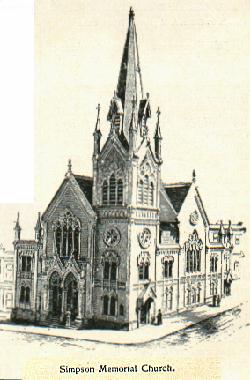
SIMPSON MEMORIAL CHURCH
"The vision of a
perfect church was always allured, rebuked and fascinated men. It is an ideal which has stirred men into
energy and ambition in shaping the zeal."
A distinguishing characteristic of a church eager to actualize such an
ideal is its aggressive activities. It
is not the quiescent but the militant church that fulfills its mission in
society. Each Methodist society
organized in San Francisco seemed to cherish this spirit, made emphatic and
actual in establishing Sunday-schools in other parts of the city. And thus laying the foundations of a new
church. The Hayes Valley Methodist
Episcopal Sunday school was organized in the old Wigwam on the corner of Van Ness
avenue and Grove street, May 7, 1876, by Rev. George Newton, city
missionary. The following July, the
school, numbering twenty-five scholars and teachers, was removed to Centennial
Hall on Hayes Street. Under the
direction of the official board of Central church, the young people's society of
that church took charge of the school, October 10, 1877, with Job Stevenson,
superintendent; W. S. Craw, assisted; Rolla V. Watt, secretary; Sarah Hillman,
treasurer. This church in embryo sustained
its life until the pressure of difficulty and discouragements. The challenge of peculiar vicissitudes evoked
a persistent spirit that was rewarded with success. At the request of James H. Humphreys, the Rev. B. F. Crary, D.
D., editor of the California Christian Advocate, preached the first sermon to the school, November 3, 1880. His wise and healthful ministrations
centralized in the organization of the Hayes Valley M. E. church, February 10,
1881. At the annual session of the
California Conference, in 1884, the name was changed to Simpson Memorial, in honor
of Bishop Matthew Simpson, D. D., and the Rev. F. F. Jewell, D. D. was
appointed pastor. He had been pastor at
Howard Street of the charter members of this new organization, and his energy
and well-balanced zeal were an inspiration to their plans for the future. The trustees, elected on the threshold of
his administration, that achieved so grandly were: Charles Goodall, Robert
McElroy, Samuel Hancock, James H. Humphreys, W. E. Fifield, Samuel Mosgrove, A.
W. Bogart and Charles E. Edwards.

The discomforts of
worshiping in Mowry Hall, on Laguna street, were a potent incentive to secure a
permanent home. The present valuable
property, and the stately edifice with its auditorium of artistic beauty, with
its large and well arranged lecture room and parlors, is the crowning result of
their labors. It was dedicated November,
1885. No debt challenges the increasing
prosperity of the church. Its
systematic organizations, of the Epworth League, the Junior League, the Ladies'
Aid Society, the Lyceum, the large and flourishing Sunday school under the
enthusiastic leadership of C. B. Perkins, the Chautauqua Circle, the Women's
Missionary Society, the well-disciplined Boys' Brigade, emphasize its strong
vitality, and its force as ennobling and evangelizing agency in San
Francisco. It was providential that Dr.
Jewell was appointed pastor when this great enterprise began. He was transferred from the Central New York
Conference, in September, 1872, and stationed at Howard street church. Uninterrupted success has distinguished all
of his pastorates. His patient and
unyielding labors at Simpson Memorial were not equaled elsewhere. They are a part of imperishable history.
With his characteristic
and undiminished energy, he is briefly meeting the heavy duties of Presiding
Elder of Oakland District. His worthy
successor was Rev. G. W. Izer, D. D.; and stimulated by his energetic efforts
the whole church aroused to new activities.
CALIFORNIA ST. AND VAN
NESS AVE. CHURCHES
The Bush street church was
organized in 1869, as the outgrowth of the Seamen's Bethel where in the early
days William Taylor had labored so heroically.
During recent years the environments of the church aroused the purpose
to secure property and build elsewhere.
It was a bold project for a small though loyal membership. Through the wisely directed assistance of
the City Church Extension Society, a large and valuable lot was secured on the
corner of California and Broderick streets, by an outlay of $14,000. The church when finished and furnished, will
cost, including the lot, about $70,000, and well be the most complete and beautiful
edifice of the denomination in the city.
Rev. Thos. Filben, A. M., the pastor, has been the master spirit to
achieve such astonishing results.
By his indomitable energy,
brave perseverance, wisdom that masters details, and enthusiasm that leaps from
the challenging environments, he emphasizes the transition from the
meeting-house and chapel, rude and cheap, to the magnificent churches wherein
assemble for worship Christians now as devote and eager for loyal service as
any of the forefathers who bore the honored name of the Methodist.
Samuel Hancock, a layman,
and active member of Howard street church, with commendable ambition for
Methodism, conceived the idea of building a magnificent and representative
church in that section of the city where it would wield a commanding
influence. Van Ness Avenue was selected
as the center desired. He has
consecrated much of his wealth to realize his ideal. A temporary chapel has been erected for church and Sunday school
services. Some peculiar and unexpected
hindrances have retarded the progress of this enterprise, but the slumbering
forces again aroused will transform this seeming defeat into positive victory.
Methodism has placed no
undue emphasis on the work of the laity.
Very much of her apostolic history is the resultant of her persistent
theory to make every member a worker.
This has aroused quiescent faculties, awakened dormant energies, and
mobilized all powers for service.

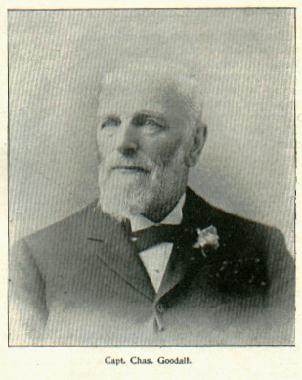
CAPT. CHAS. GOODALL
Preachers were not the
only toilers who laid broad and deep foundations of Methodism in
California. There were consecrated,
self-sacrificing layman who wrought to give quality and quantity to the moral
currents of the future of the State. The sheet anchor that held them amid the wild,
rushing waves of secularity, was faith in God.
To their thought, permanent prosperity was only possible through a
quickened individual conscience, elevated morals, ascending the tides of pure
life through all the social, commercial and political avenues of the
people. Men thus equipped and ennobled
must exert a purifying influence on the world-incrusted hearts of their
fellows, and as artists chisel into unfading beauty the moral features of
mankind.
Brilliant genius and
superior intellectual endowments do not alone win the highest prices possible
in the arena of life; but highest purpose, firm will, true manhood, unwavering courage,
all presided over by common sense and intelligence, although that intelligence
may have no such potential sweep as that of an Aristotle or Bacon. These are the elements ensphered in the
character of Capt. Chas. Goodall, a man's self-trained, self-taught. He reached the State in 1850, and became
identified at once with Methodism by membership with Powell street church in
those days of poverty and struggle.
Since then every enterprise denominational or educational has felt the
impulse of his wise and loving council, and secured vigor for successful
aggressiveness through his large contributions. Greatly prospered in business, he has made large investments in
churches, schools and philanthropic enterprises.
This is notably true in
reference to Howard street church, Simpson Memorial church, Van Ness avenue and
California street church's and the University of the Pacific. As an honored and useful member of the
Simpson Memorial Church the elements of his positive and symmetrical character
are a crown to his mature manhood, purity of motive, sincerity of conviction,
elevation of sentiment, brave loyalty to his friends, a chivalrous sense of
honor in business, and an all-controlling desire for the triumph of
Christianity. His noble wife has been
harmoniously identified with him in all his philanthropic and Christian
work. Beautifully their lives have
blended in holy ministries.
"As unto the bow the cord is,
So unto the man is the woman.
Though she bends him, she obeys him,
Though she draws him, yet she follows him;
Useless each, without the other."
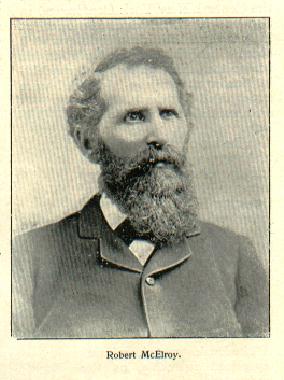
R. McELROY
Not every one who in the
early days sought California was actuated by the greed for gold. Some came in search of health, a far richer
blessing than wealth. This State was
already famed for its delicious, health-restoring climate, as well as its latent
industrial and commercial activities. A
young man twenty-six years of age arrived in San Francisco, June 1st 1853, from
New York. That man was Robert
McElroy. His journeyed by way of the
Isthmus was an eventful and romantic one, as the elect lady whom he married
three years afterwards was in that company of travelers. His zeal, fervor, and irrepressible enthusiasm
as a preacher and pastor in the East, had overtaxed his physical powers. His unwilling but permanent retirement from
the ministry was a necessity.
California was the chosen sanitarium.
He has been through the years a worthy colleague of Capt. Goodall. He has likewise been successful in his
business enterprises, by honesty, integrity and a keen insight into practical
affairs. The large demands made upon
his generosity by the various denominational and charitable enterprises have
not been disregarded.
He wields a trenchant pen,
and has written much for the public, and thus has aided in an eminent degree to
shape and elevate individual thought and life.
His poetical nature gives ofttimes a beauty, pathos and rhythm to the
vigorous sentences that flow from his pen.
Simpson Memorial enjoys is wise counsel and faithful work.
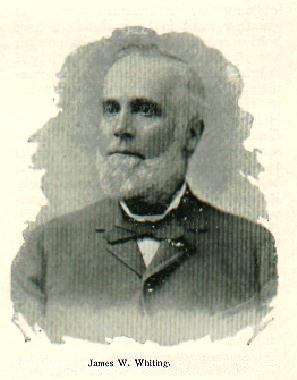
JAMES W. WHITING
The aggregate force of
Methodism as a religious and influential power is not complete unless it
combines the concentrated spiritual life and consecrated energies of laity. These perilous times demand that Christian men
of business should carry the glow of a spiritual life to the marts of trade and
put a sacred claim on their gains for the advance of Christianity. Such man wield the sinews of war. Such man recognize that culture, wealth,
highest social elevation, personal ambition should all be in subordination to
the higher purpose of building up a stalwart, symmetrical character, and
realizing the possibilities of a true manhood emancipated from sordid motives
and selfish secularities.
James W. Whiting is a layman
of many qualities, commendable generosity, warm human sympathies and unfailing
loyalty and fidelity to the church. He
is the only surviving male member of the faithful twenty-three that organized the
Second Church of San Francisco. As a
Christian citizen he has the courage of his convictions, makes no compromise with
wrong, and zealously plans and works for the church. Scores of layman in the present city churches strike as nobly for
the right and truth as these pioneers.
Such are the human potentialities that give pledge for a pure
civilization.
Bishop C. H. Fowler, who
resided in San Francisco for eight years, and under whose wise and aggressive
administration the church made such splendid advances, thoroughly understood
the conditions in this State. The inspiring
and penetrating sentences he delivered at the Second Ecumenical Conference in
Washington October, 1891, have an emphatic significance as applied here.
"Her highest want is
the maintenance of a firm hold upon the supernatural. Unless Methodism is supernatural, she is nothing. She was called into being to hear testimony
to the great fact of the supernatural world.
Like Christianity in every age, she has gained all her victories by her
lead with supernatural forces. Our
greatest want is to maintain a firm hold upon a supernatural religion that
except science as a re-want, and laughs her out of camp as a commander,
contented to go up or down with Almighty God.
Our next need is ideas. We must
reach out in all directions with the appliances necessary for varied successes. We ought to capture and utilize every secret
that brings success to any other church.
The Romanism, with no pretense to converting grace, does a large
business by the power of her organization and off her architecture. The Protestant-Episcopal Church achieves
commendable success by her social forces.
Congregationalism makes itself useful by her emphasis upon education. Presbyterianism holds a front line by her family
and family training. The great Baptist
church pushes forward by her immense energy and definite ceremony, and by
counting as good fish everything that comes into her deep-sea net. The Salvation Army is rolling up a host of
good workers by abandoning her pride and respectability to start with, and by
providing no provision for drones. It
is work or die. Methodism needs
encourage to seize and utilize all these ideas from the Cathedral to the Rescue
Mission, from the University to the family, from the organ to the tambourine,
from the great preacher to the weeping tramp.
There must be no power too great for us to master and no instrument too
humble for us to utilize. In the past
we have legislated from the standpoint of the circuit. For the future we must legislate from the
standpoint of the cities. The cities
are the forts. Whoever holds them holds
the future. The problem given us by
Providence, which we must solve or perish, is how to save the cities. At all costs we must reach all classes and
unite them in a common faith and in a common brotherhood."
The splendid results
already achieved in this State by Methodism as an evangelizing and educating
agency, is but the harbinger of a resplendent day.
Source: The Californian
Illustrated Magazine, December 1892-May 1893, Volume III, Edited by Charles
Frederick Holder. San Francisco.